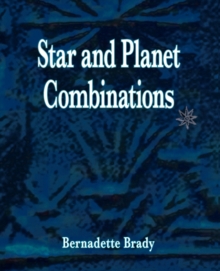1 Items - £28.00
Are you outside of the UK?
Hi! It looks as though you're visiting us from outside the UK which means that shipping will be more expensive and you're also likely to be charged import duty/taxes on your purchase. Have you tried your usual bookseller? Our titles are available through worldwide distribution, so you should be able to buy them in your own country, thereby saving a small fortune. To find out more please visit our FAQ page.I Understand

This is a much needed textbook on fixed stars and their relationship to the natal planets. It offers rare material on the detailed interpretations of an individual’s natal heliacal rising and setting stars; these stars yield insight into the nature of one’s soul and spiritual path. Additionally, the author gives a comprehensive listing of the meaning of every star when combined with all the planets and nodal axis, for natal as well as predictive use.
In ancient times, astrologers were keen skywatchers and paid special attention to the rising, culminating, and setting of stars. Their observations included the stars that were far from the ecliptic (the path of the Sun), and how the stars reached these critical points at different times for different latitudes. Gods and goddesses were connected to the constellations, as the entire sky seemed animated or enchanted with the heroes of their mythologies. If a planet was culminating (at the Midheaven) when an important star was rising, the two formed a "paran," a special relationship between the star and planet that had far-reaching consequences. Bernadette Brady has distinguished herself by studying the stars and how they can infuse their powers onto the planets in her ground-breaking new book, Star and Planet Combinations. Nowadays, astrologers who use the stars in their interpretations generally consider only the conjunction or opposition to planets, and these alignments are determined by projecting the stars’ longitude onto the ecliptic. It's a limiting two-dimensional perspective that misses the big picture. The ancients knew that most stars rise and set far from the ecliptic, but when astrologers began tabulating and organizing the star positions, it became easier to just note the degree where the star aligned with the ecliptic. Soon astrologers were determining stars' significance by associated them with a planet or two planets. Thus, Bellatrix was said to be like Mercury and Mars, Sirius like Jupiter and a touch of Mars, and Antares like Mars and Jupiter. Brady's point of view is that these reductionist interpretations are missing out on the rich symbolism that was encoded in the mythologies. Plus, most of the stars' influences were ignored, since the parans brought into play many more stars that weren't in a conjunction or opposition. Paran is short for paranatellontato, which was the original word as defined by Vetius Valens about two thousand years ago. Its meaning may be difficult to grasp because it involves the great dome that is our sky, the visual night world which has generally been lost by living in illuminated cities. If you observe the sky, and notice that a bright star is setting just as Jupiter is culminating, then you have noticed a paran. As Brady writes, "a paran is simply the simultaneous rising, setting, or crossing of the meridian (above and below) of planets and/or stars." Until Brady's pioneering work (that began with the 1998 publication of Fixed Stars), astrologers have left parans out of their calculations. It would take too many reference books to note all the possible parans of all the significant stars at all the latitudes. But now, some astrology calculation programs will do all the work for you, and in just a few clicks of the mouse. If you're serious about studying the stars and their parans, you'll eventually need one of these programs, but in the mean time, Star and Planet Combinations will get you started. Of the 9,000 stars visible to the naked eye, Brady has settled on 64 that have pronounced symbolism in the charts of the famous and the ordinary. Her criteria for electing these 64 include using the brightest stars, those close to the ecliptic, but also many that aren't very bright and are far from the ecliptic. This last group came about because of their prominent place in mythology, as well as their evident powers in natal horoscopes. The first quarter of Star and Planet Combinations introduces the subject matter, and provides tables to look up your Heliacal Rising and Heliacal Setting stars. Again, these stars aren't the same for every latitude, so you look up the star tables particular to the latitude where you were born. To whet your appetite, the author gives a few celebrity examples to show how clearly the stars influence the individuals' lives, including their expected rise to fame and the specific tasks or problems associated with that fame. Then, the rest of the book is devoted to delineating the 64 stars. The myths, ancient associations, and the star in paran with the ten planets are all discussed. The tables included in the first section are only meant to provide you with a few of the parans, and for the rest, you'll need calculation software. But even with this glimpse, the devoted student will notice how relevant star parans are to our lives. In my view, this is one of the most exciting fields of work open to astrologers. Stars have immense potential in financial or mundane astrology, and can be counted on for predicting celebrity status, as well as falls from grace. Using the stars incorporates the entire collective psyche, rather than a narrow band of consciousness.
Chris Lorenz Dell Horoscope

 Moment of Astrology - Origins in Divination
Moment of Astrology - Origins in Divination 

